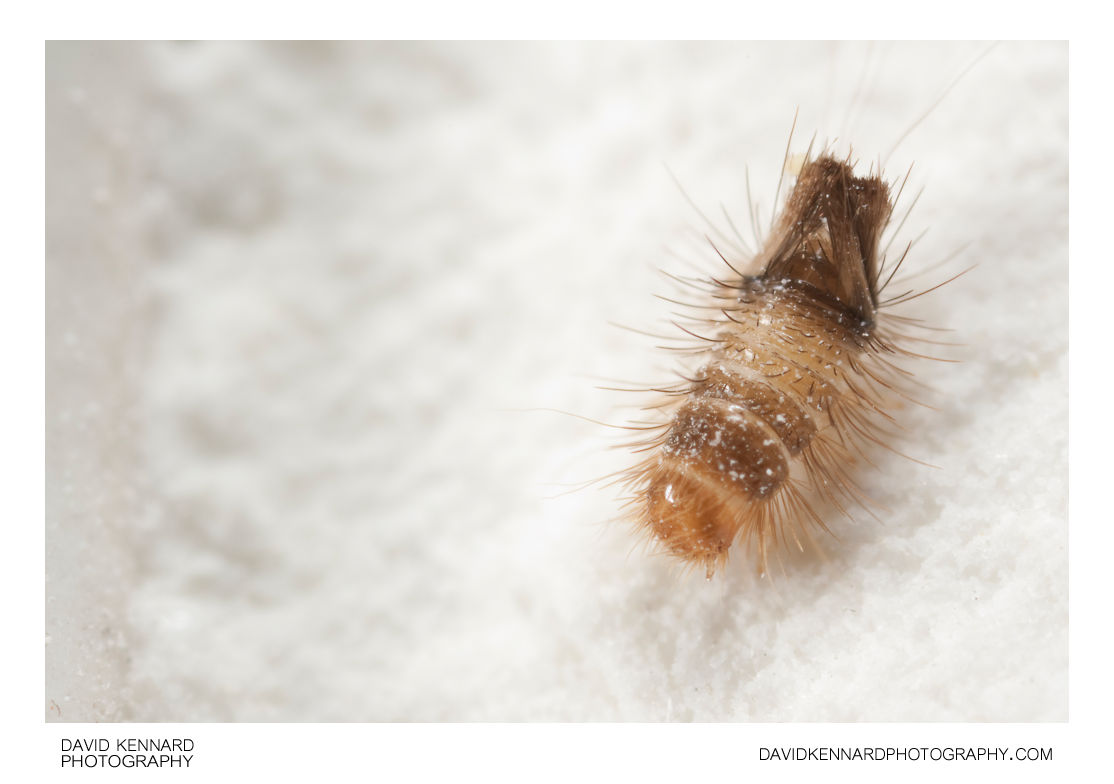Varied Carpet Beetle (Anthrenus verbasci) larva

Description
- Title:
- Varied Carpet Beetle (Anthrenus verbasci) larva
- Caption / Description:
-
The varied carpet beetle (Anthrenus verbasci) is a 3 mm-long beetle that can be a serious household pest. It feeds on natural fibers and can damage carpets, furniture and clothing.
The larval form is known as a woolly bear, a name it shares with the larvae of Pyrrharctia isabella.
A. verbasci was the first insect to be shown to have an annual circadian rhythm and to date remains a classic example of circannual cycles in animals.
The larval form of A. verbasci are roughly 4-5 mm in length. The body is covered in a pattern of alternating light- and dark-brown stripes. The body is usually wider at the back than at the front and also bears 3 pairs of hair tufts along its rear abdomen that can be used for self-defense.
A. verbasci has an unusual life cycle for an insect, developing from larvae to adult in 1-3 years, depending on the environmental conditions. Larvae hatch from eggs in the spring and early summer, often in the nests of birds (including those of the House Sparrow and House Swift) or around stored fabrics. Larvae feed on natural fibers throughout their development, eventually experiencing a dormancy period (also known as diapause) prior to pupation into the adult stage. The length of the dormancy appears to depend on environmental factors, with the most likely zeitgeber being photoperiod.
Adults emerge between late May and early August, flying to and feeding on the pollen of flowering plants. During this period, mating occurs, eggs are laid, and the cycle begins anew.
The larvae of A. verbasci is a common household pest. Adult beetles usually lay their eggs in air ducts, in closets, under furniture, or under baseboards. Once hatched and until they pupate into adults, the larvae hide in dark, undisturbed areas and feed on organic material. The larvae are thus responsible for the damage of various items, such as furniture, clothing, blankets, furs, and carpets. Collections of specimens, especially of insects, are also vulnerable to attack, making A. verbasci a common pest in museums.
Description from Wikipedia: http://en.wikipedia.org/wiki/Anthrenus_verbasci
- Tags / Keywords:
-
- Biota
- Life
- Vitae
- Eukaryota
- Animalia
- Animals
- Arthropoda
- Arthropods
- Insecta
- Insects
- Coleoptera
- Beetles
- Varied Carpet Beetle
- Dermestidae
- Skin Beetles
- Carpet Beetles
- Anthrenus
- Anthrenus verbasci
- Larvae
- Woolly bear
Admin
- Date Original Photo Taken:
- Original File Name:
- _MG_9240.CR2
- Event:
- Rating:
- ☆
- Date this image added/last updated on website:
- Original File Dimensions:
- 4272px x 2848px
- File Type:
- JPEG
- Color Mode:
- RGB
- Original Image Color Profile:
- Adobe RGB (1998)
Location
- Location Created:
-
- Sublocation:
- City:
- Market Harborough
- Province/State:
- Leicestershire
- Country:
- United Kingdom
- World Region:
- Europe
- Geo-location:
Rights
- Copyright Status:
- Copyrighted
- Licensing Status:
- Rights Managed
- Available for Editorial Use:
- Yes
- Available for Commercial Use:
- Yes
- Copyright Notice:
- © 2010 Dave Kennard
Camera Data
- Date Digital Resource was created:
- Shutter speed:
- 1⁄200 s
- Aperture:
- f/8
- Camera Model:
- Canon EOS 450D
- ISO:
- 200
- Exposure Compensation:
- 0
- Focal Length:
- 65mm
- Focal Length (35mm equiv.):
- Metering Mode:
- Multi-segment
- Flash:
- On, Fired
- Exposure Mode:
- Manual
- White Balance:
- Manual
- Light Source:
- Exposure Program:
- Manual
Additional shooting metadata
- Lens:
- Canon MP-E 65mm F2.8 1-5x Macro
- Filters used:
- Additional Optics used:
- Setup:
- Handheld
Canon MT-24EX Macro Twin Flash
Post Processing
- Image Modified:
- Software used:
- Post Processing:
